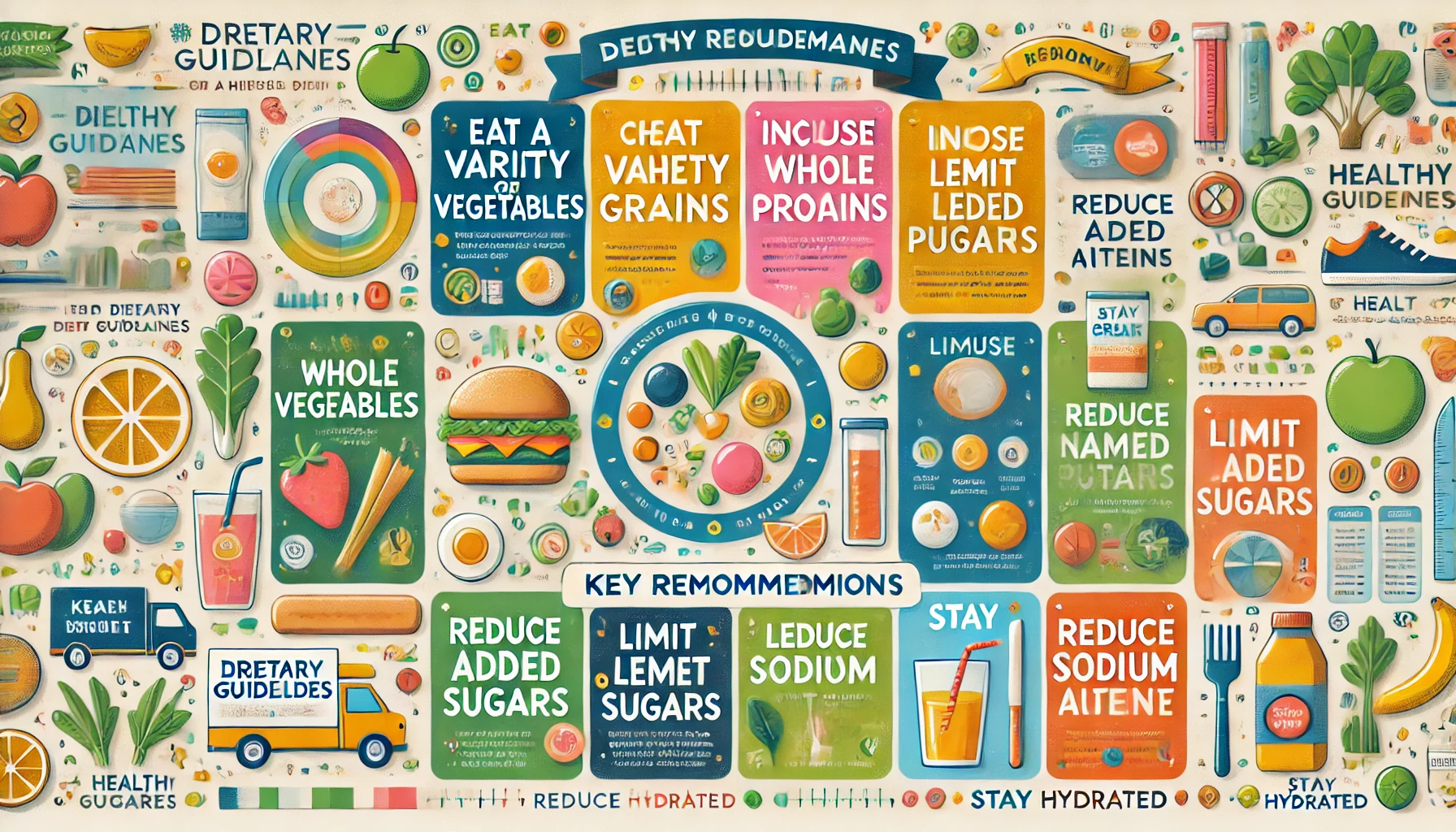Key Recommendations of the Dietary Guidelines for a Healthy Diet
Dietary Guidelines for a Healthy Diet
Maintaining a healthy diet is essential for overall well-being, and understanding the key recommendations of the dietary guidelines can help you make informed choices. These guidelines provide a roadmap to eating healthier, with the ultimate goal of promoting long-term health. Let’s delve into these recommendations and explore how you can incorporate them into your daily life.
1. Follow a Healthy Eating Pattern Across the Lifespan
The foundation of a healthy diet is establishing a consistent eating pattern that you can maintain throughout your life. This involves choosing a variety of nutrient-dense foods in appropriate amounts. A balanced eating pattern includes:
- Fruits and vegetables: Aim to fill half your plate with fruits and vegetables, focusing on a variety of colors and types.
- Grains: Make at least half your grains whole grains, such as brown rice, whole-wheat bread, and oatmeal.
- Protein: Include a mix of protein sources, such as lean meats, poultry, seafood, beans, peas, and nuts.
- Dairy: Opt for low-fat or fat-free dairy options, like milk, yogurt, and cheese.
2. Focus on Variety, Nutrient Density, and Portion Sizes
Variety is key to ensuring you get all the essential nutrients your body needs. Nutrient-dense foods provide vitamins, minerals, and other beneficial substances with relatively few calories. Keep an eye on portion sizes to maintain a healthy weight and avoid overconsumption.
3. Limit Added Sugars, Saturated Fats, and Sodium
Reducing added sugars, saturated fats, and sodium is crucial for heart health and preventing chronic diseases. Here are some practical tips:
- Sugars: Keep added sugars to less than 10% of your daily calories. Be mindful of sugary drinks and snacks.
- Fats: Limit saturated fats to less than 10% of your daily calories by choosing lean meats and low-fat dairy products and cooking with healthier oils like olive or canola oil.
- Sodium: Aim to consume less than 2,300 milligrams of sodium per day. Reduce salt use and choose fresh or minimally processed foods.
4. Choose Healthier Beverage Options
Beverages can significantly impact your overall calorie intake and nutrient profile. Water should be your primary drink. It’s calorie-free and vital for hydration. Other healthy options include:
- Unsweetened tea
- Black coffee
- Low-fat or fat-free milk
Avoid sugary beverages like soda and energy drinks, which can contribute to weight gain and increase the risk of type 2 diabetes.
5. Engage in Regular Physical Activity
While diet is crucial, physical activity is equally important for maintaining a healthy lifestyle. Adults should aim for at least 150 minutes of moderate-intensity aerobic activity each week, along with muscle-strengthening activities on two or more days a week. Find activities you enjoy, such as walking, swimming, or cycling, to make exercise a regular part of your routine.
Practical Tips for Implementing Dietary Guidelines
Incorporating these guidelines into your daily life can be simple with a few practical strategies:
- Meal Planning: Plan your meals and snacks in advance to ensure they align with dietary guidelines.
- Read Labels: Check nutrition labels to make informed choices about the foods and beverages you consume.
- Healthy Substitutions: Swap out less healthy ingredients for more nutritious options, such as using Greek yogurt instead of sour cream or choosing whole-grain bread over white bread.
- Mindful Eating: Pay attention to your hunger and fullness cues, and avoid eating out of boredom or stress.
To make your diet healthier and more sustainable, following the dietary guidelines is essential. These recommendations are designed to improve your overall health and well-being. By focusing on a balanced eating pattern, incorporating a variety of nutrient-dense foods, and being mindful of portion sizes, you can achieve a healthier lifestyle. Remember to limit added sugars, saturated fats, and sodium, and choose healthier beverage options to complement your diet. Regular physical activity is also a key component of maintaining good health. By implementing these strategies, you can enjoy the benefits of a healthier diet and a more active lifestyle.
Examples and Tips
Understanding and implementing these dietary guidelines can transform your eating habits. Here are some examples and tips to help you get started:
- Breakfast: Swap out sugary cereals for oatmeal topped with fresh fruit and a sprinkle of nuts.
- Lunch: Choose a salad loaded with a variety of vegetables, lean protein like grilled chicken, and a vinaigrette dressing.
- Dinner: Opt for a balanced plate with grilled fish, quinoa, and steamed vegetables.
- Snacks: Reach for fruit, nuts, or low-fat yogurt instead of chips or candy.
Conclusion
By adhering to these key recommendations, you can significantly improve your diet and overall health. The dietary guidelines provide a comprehensive approach to healthy eating, emphasizing variety, nutrient density, and moderation. Incorporate these principles into your daily routine to build a foundation for long-term health and well-being. Remember, making small, consistent changes can lead to significant improvements over time. Stay committed, and enjoy the journey to a healthier you!
Implementing these dietary guidelines doesn’t have to be daunting. With a little planning and mindful choices, you can easily make them a part of your everyday life. Happy healthy eating!






